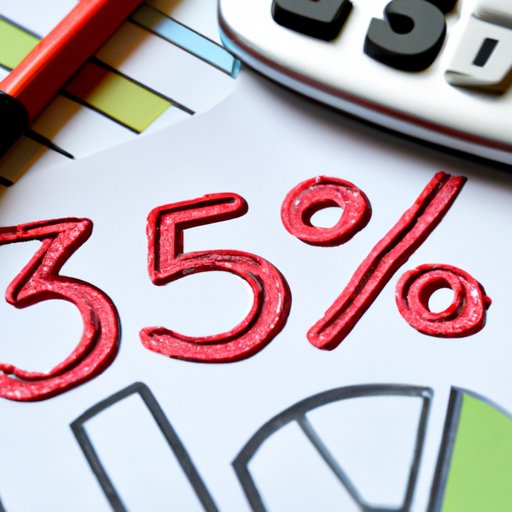Introduction: Understanding Percentages
Percentages are a way of expressing a portion of whole as parts per hundred. They are used in a variety of fields such as finance, business, science, sports, and more. Knowing how to calculate a percentage is essential to everyday life as well as professional pursuits. In this article, we will provide a comprehensive guide on how to calculate percentages, including tricks, shortcuts, and real-world examples.
A Step-by-Step Guide to Calculating Percentages for Beginners
A percentage is a way of expressing a fraction or a ratio as a decimal multiplied by 100. The percentage symbol “%” is used to represent the percentage. For example, 25 percent can be written as 0.25 or 25/100.
There are some basic principles and rules that you need to keep in mind while calculating percentages. Firstly, percentages cannot be added, subtracted, or multiplied as though they were ordinary numbers. Secondly, percentages are always taken out of a base number or datum. Thirdly, when calculating percentages, it is crucial to be clear what you are finding a percentage of.
Let’s take an example to understand these principles better. You got 21 out of 30 questions right in a test. To find the percentage of correct answers, you need to divide 21 by 30 and then multiply by 100 to convert it into a percentage.
Percentage = (21/30) x 100
Percentage = 70%
To practice calculating percentages, you can try some simple problems. Assuming you have a calculator at hand, try the following practice problems:
Problem 1: Find 35% of 80.
Solution: Percentage = (35/100) x 80 = 28
Problem 2: What percentage of 200 is 50?
Solution: Percentage = (50/200) x 100 = 25
Demystifying Percentages: How to Convert Fractions and Decimals into Percentages
It is also imperative to know how to convert fractions and decimals into percentages. A fraction represents a part of a whole, usually expressed as one integer divided by another. A decimal is a fraction expressed in a base 10 positional notation system.
To convert a fraction into a percentage, you need to divide the numerator by the denominator and then multiply by 100.
Percentage = (Numerator/Denominator) x 100
For example, if you want to convert the fraction 3/4 into a percentage, you need to divide 3 by 4 and then multiply by 100.
Percentage = (3/4) x 100 = 75%
To convert a decimal into a percentage, you need to multiply the decimal by 100.
For example, if you want to convert the decimal 0.25 into a percentage, you need to multiply by 100.
Percentage = 0.25 x 100 = 25%
Try some more practice problems to test your understanding:
Problem 1: Convert the fraction 5/8 into a percentage.
Solution: Percentage = (5/8) x 100 = 62.5%
Problem 2: Convert the decimal 0.75 into a percentage.
Solution: Percentage = 0.75 x 100 = 75%

The Importance of Calculating Percentages in Daily Life and Business
Calculating percentages is crucial for personal finance, business management, and scientific research where you need to analyze and interpret data.
In real-world situations, percentages help in understanding discounts, taxes, tips, interests, and profit margins. For example, when you go shopping, you would like to calculate the percentage discount offered on a product. Similarly, when you invest in a stock, you need to calculate the percentage of return on investment.
Moreover, businesses use percentages to monitor sales, expenses, and profits. They help identify trends, patterns, and opportunities for growth. Calculating percentages can save time and money by providing insight into how resources can be allocated effectively.
Tricks and Shortcuts for Calculating Percentages Mentally
While a calculator is always helpful, sometimes you may need to calculate percentages mentally. Here are some quick methods that can help:
1. To calculate 10% of any number, divide the number by 10.
For example, if you want to find 10% of 80, you can divide 80 by 10 which gives you 8.
2. To calculate 5% of any number, first calculate 10% and then halve it.
For example, if you want to find 5% of 80, you can first find 10% which is 8, and then halve it to get 4.
3. To calculate 1% of any number, divide the number by 100.
For example, if you want to find 1% of 80, you can divide 80 by 100 which is 0.8.
Try these examples:
Problem 1: What is 15% of 120?
Solution: You can calculate 10% by dividing 120 by 10 which is 12. Using the shortcut method, you know that 5% is half of 10%, so 5% is 6. Finally, you can add 10% and 5% to get 15%, which is 12 + 6 = 18.
Problem 2: What is 20% of 85?
Solution: You can calculate 10% by dividing 85 by 10 which is 8.5. To get 20%, you can double it which is 17.
Top Mistakes to Avoid When Calculating Percentages
When it comes to calculating percentages, there are some common errors that people make. Here are some top mistakes to avoid:
1. Forgetting to convert the decimal or fraction into percent form.
2. Confusing percentage increase and percentage decrease.
3. Incorrectly calculating percentage change by using addition instead of multiplication.
To avoid these mistakes, double-check your calculations and use the correct formulas. If you’re unsure, ask for help or use a calculator.
How to Calculate Percentage Change in Data Analysis
Percentage change is used to measure the increase or decrease in a value over time. It is especially useful in data analysis to track trends and growth. The formula for percentage change is:
Percentage Change = (New Value – Old Value)/ Old Value x 100
For example, if the sales for a company increased from $100,000 in 2018 to $150,000 in 2019, the percentage change can be calculated as:
Percentage Change = (150,000 – 100,000)/100,000 x 100 = 50%
Practice these examples:
Problem 1: The price of a stock increased from $40 to $50. What is the percentage increase?
Solution: Percentage Increase = (50 – 40)/40 x 100 = 25%
Problem 2: The temperature decreased from 90°F to 75°F. What is the percentage decrease?
Solution: Percentage Decrease = (75 – 90)/90 x 100 = -16.67%
Real-World Examples of How to Use Percentages in Problem-Solving
Here are some real-world examples of how to use percentages in problem-solving:
1. Calculating a tip at a restaurant.
2. Finding the percentage increase in salary after a raise.
3. Determining the percentage of discount on a sale item.
4. Analyzing the monthly percent change in revenue for a business.
By mastering percentage calculations, you can solve a wide range of problems and make informed decisions in your personal and professional life.
Conclusion: Putting Your New Skills into Practice
Calculating percentages is a fundamental skill that is essential for everyday life and business. By following the step-by-step guide provided in this article, you can learn the basic principles and rules of calculating percentages, as well as tricks and shortcuts for mental math. Remember to avoid common mistakes and practice solving problems in real-world scenarios. By doing so, you will be able to improve your problem-solving skills and make more informed decisions.
Now it’s time to put your new skills into practice! Try solving some percentage problems in your daily life and see how much easier it becomes.
